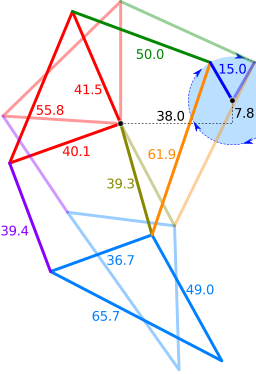Back in the 1990’s Dutch Artist Theo Jansen created a number of kinetic sculptures he named Strandbeest.

By Eloquence; cropped by Beyond My Ken (talk) 18:45, 7 May 2011 (UTC) (Own work) [Public domain], via Wikimedia Commons
They were constructed from PVC pipe and roamed the beaches powered by the wind. The walking mechanism that Jansen settled on was computer optimised, and consisted of a set of 11 measurements that described 8 linkages which turned rotary motion into a walking gait. The optimisation was based on a simple evolutionary approach, whereby 1500 legs were generated with linkages of random lengths, the successful results were used to create the next generation. This is a prime example of machine learning.

By Mliu92 [CC BY-SA 4.0], via Wikimedia Commons
Eleven holy numbers
“…This process went through many generations during which the computer was on for weeks, months even, day and night. It finally resulted in eleven numbers denoting the ideal lengths of the required rods. The ultimate outcome of all this was the leg of Animaris Currens Vulgaris. This was the first beach animal to walk. And yet now and then Vulgaris was dead set against the idea of walking. A new computer evolution produced the legs of the generations that followed.
These, then, are the holy numbers: a = 38, b = 41.5, c = 39.3, d = 40.1, e = 55.8, f = 39.4, g = 36.7, h = 65.7, i = 49, j = 50, k = 61.9, l=7.8, m=15 . It is thanks to these numbers that the animals walk the way they do.”
STRANDBEEST. Retrieved September 27, 2016, from http://www.strandbeest.com/beests_leg.php
My aim is to use modern machine learning algorithms to see if these linkage lengths can be further optimised for powered walking robots, which could navigate uneven terrain more efficiently than wheeled robots.

By MichaelFrey (Own work) [GFDL (http://www.gnu.org/copyleft/fdl.html) or CC BY-SA 3.0 (http://creativecommons.org/licenses/by-sa/3.0)], via Wikimedia Commons